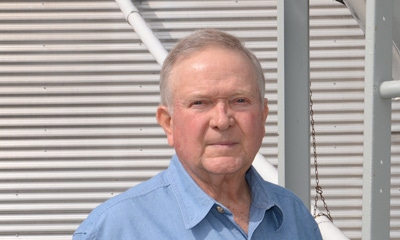
The beginning of John Hardin’s interest in agricultural trade dates back 50 years. He was an exchange student to New Zealand in 1965 and 1966 in the International Farm Youth Exchange program. He would never look at America the same again.
“Farmers there had to export ag products to live,” says Hardin, Danville farmer and past chairman of the U.S. Meat Export Federation. “It was very competitive. When you spend time in a foreign country, you become immersed in what happens there. I began to understand why things were the way they were there.”
Benefits of trade

UNDERSTANDS VALUE OF TRADE: John Hardin was in a key position in the late 1980s and helped lay the groundwork for expanded ag exports. He believes it’s time to act again.
Chris Hurt, Purdue University Extension ag economist, says the story of how U.S. pork exports increased over the past 25 years is extraordinary. Applying lessons learned two decades earlier, Hardin was in a key position to help bring about the change.
“It all began with the Uruguay Round of trade talks in 1985,” Hardin says. “It started under Ronald Reagan and didn’t conclude until 1993. By then Bill Clinton was president, and he was a free trade guy.”
Hardin was directly involved, representing the National Pork Producers Council when he served as its president, and representing the USMEF. From 1991 to 2001, he was on the Agricultural Policy Advisory Committee for Trade, which advises trade negotiators.
Trade talks take time to work out the rules of trade, Hardin says. “You can’t have free trade without rules that all countries abide by. Increasing exports for a product like pork is all about access. We gain access to markets through trade negotiations.”
There was a fundamental change in the world from 1985 through 2010, when 1 billion people joined the middle class, many of them in Asia.
Hardin says Bob Thompson, former Purdue University dean of agriculture and later head of the World Bank, explained it this way: “When per-capita income rises from $2 per day to $10 per day, 80% of the increase goes for better food.”
That was $6.4 billion more spent on food every day, Hardin says. Some of it went to meat and poultry products. Coupled with trade agreements, pork exports exploded.
Future for trade
“Farmers should understand that they have a stake in trade negotiations,” Hardin says. He encourages everyone to pay attention to the attitude of different candidates on trade agreements.
Hardin has two major concerns. One is that the current rules of trade, established over long periods of negotiations, be left in place because they work. The second is that if trade negotiations are reopened, agricultural exports could be at risk.
U.S. ag products are targeted by foreign countries if trade disputes arise. Ag products are sensitive to trade issues, he says. Upheaval in trade agreements could put the future of ag exports at risk.
The Trans-Pacific Partnership was negotiated but never brought to Congress. If approved, it could open access to pork exports in places like Vietnam, Hardin says. China is not part of that agreement.
“Proponents don’t believe there are enough votes in Congress to pass it [TPP],” he says. “It’s not a partisan issue. As farmers, we ought to know what attitudes elected officials and candidates have on this agreement. We need to elect those who can meet in the middle and pass this agreement.”
About the Author(s)
You May Also Like




